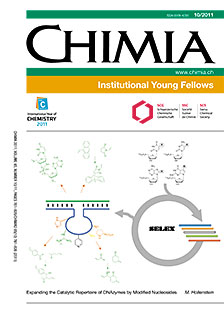Towards Biologically Active Self-assemblies: Model Nucleotide Chimeras
DOI:
https://doi.org/10.2533/chimia.2011.782Keywords:
Copolymer, Dna, Functional nanostructures, Self-assemblyAbstract
With this article, we wish to give an overview of our main research activities assessing the potential of a suitable polymer modification of DNA fragments to self-assemble biologically active nanostructures. Specifically, the grafting of a hydrophobic polymer segment on DNA fragments results in amphiphilic nucleotide-based macromolecules, which, owing to both chemical and physical incompatibility, organize in self-assembled structures either on surfaces or in aqueous solution. Through the combination of the existing know-how in polymer chemistry with modern analytical techniques, we are currently focusing on establishing the mechanism of self-assembly of the polymer-modified nucleotide sequences in solution and on surfaces prior to the assessment of their hybridization capacity once involved in the ensemble. With the evaluation of the potential of the functional nanostructures to undergo biological-like adhesion through hybridization one can eventually foresee that the optimal functionality of these bio-inspired systems could be fine-tuned for biological applications such as drug delivery, gene therapy, tissue engineering and the design of either biomedical devices or biosensors.Downloads
Published
2011-10-26
Issue
Section
Scientific Articles
License
Copyright (c) 2011 Swiss Chemical Society

This work is licensed under a Creative Commons Attribution-NonCommercial 4.0 International License.
How to Cite
[1]
C. Vebert-Nardin, Chimia 2011, 65, 782, DOI: 10.2533/chimia.2011.782.







